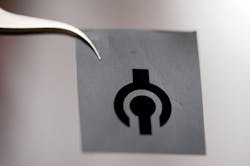Although the process of turning graphite oxide into a supercapacitor turns out to be very simple, it was not immediately obvious to the scientific community until Rice University (Houston, TX) researchers discovered the technique.
The discovery was based on the fact that graphite oxide (GO)—which can soak up water like a sponge—holds ions (becomes an ionic conductor) and serves as a solid electrolyte when hydrated. Laser illumination removes oxygen from the GO surface and converts it to dark, porous reduced graphite oxide (RGO), an electrical conductor.
Laser-written (with approximately 1 µm accuracy) patterns in a sandwich of RGO-GO-RGO materials create a conducting electrode separated by a solid electrolyte—in effect, a fully functional free-standing supercapacitor. Hydrated GO films (solid electrolyte) can have proton-transport characteristics similar to Nafion, a commercially available fluoropolymer-copolymer material used in proton-exchange-membrane (PEM) fuel cells. University of Delaware (Newark, DE) self-discharge testing of the patterned devices confirmed that they perform as well as existing thin-film micro-supercapacitor materials. The graphite supercapacitor could be used as a power source for small devices and is scalable for larger devices as well.
Contact Pulickel Ajayan at [email protected].

Gail Overton | Senior Editor (2004-2020)
Gail has more than 30 years of engineering, marketing, product management, and editorial experience in the photonics and optical communications industry. Before joining the staff at Laser Focus World in 2004, she held many product management and product marketing roles in the fiber-optics industry, most notably at Hughes (El Segundo, CA), GTE Labs (Waltham, MA), Corning (Corning, NY), Photon Kinetics (Beaverton, OR), and Newport Corporation (Irvine, CA). During her marketing career, Gail published articles in WDM Solutions and Sensors magazine and traveled internationally to conduct product and sales training. Gail received her BS degree in physics, with an emphasis in optics, from San Diego State University in San Diego, CA in May 1986.
